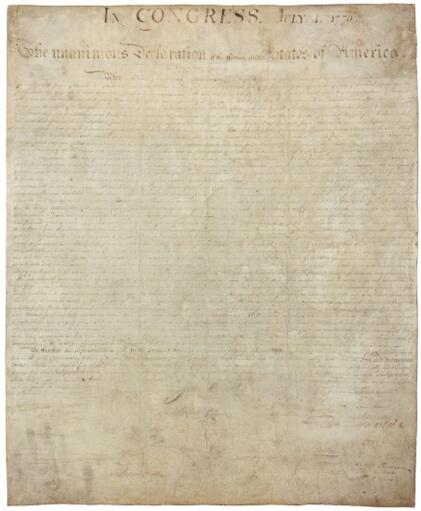Digital Field Trip
The digital field trip to view the Founding Documents Gallery at the National Archives allows for the exploration of historically crucial papers that contributed to the shaping of American society. The Declaration of Independence was chosen as the focus of the reflection on the field trip because of its role in defining the principles upon which the government, as well as the identity of US citizens, were shaped. The purpose of this paper is not only to explore the chosen document but also identifying links to contemporary issues in governmental or cultural patterns.
Declaration of Independence
The Declaration of Independence is a unique document because of its power despite not being legally binding. As mentioned by Abraham Lincoln, the Declaration was “a rebuke and a stumbling-block to tyranny and oppression” (“The Declaration of Independence,” n.d.). The document (see Figure 1) inspired people to fight for their freedom and equality rights, among which are life, liberty, and happiness pursuit. In many ways, the Declaration represents the American Dream, the national ethos, and the set of ideals in which freedom implies the opportunity for success with few social barriers.

History
The movement for America’s independence from the British Crown in 1775-1776 prompted the delegates of the Continental Congress to vote on the issue of the colonies’ opposition. At the beginning of the Revolutionary War, very few colonies desired independence from Britain; however, it changed after the Crown’s attempts to crush rebels with a large army. In the middle of June 1776, Thomas Jefferson, Benjamin Franklin, and John Adams were assigned the responsibility to create a document that would formally state the intentions and desires of the colonies (Newman & Onuf, 2013).
On July 4, 1776, the Declaration of Independence was formally adopted by Congress, signifying the birth of the United States’ independence. Therefore, the document was born from the struggle of colonies to establish autonomy and guarantee equal rights for their residents.
Modern Days
When reflecting upon the relevance of the document in modern times, the issue of racial relations comes to mind. While the Declaration clearly states that “all men are created equal, that they are endowed by their Creator with certain unalienable Rights, that among these are Life, Liberty and the pursuit of Happiness,” the American society post-Declaration still had a long way to go to reach true equality (“The Declaration of Independence,” n.d.).
Therefore, there is a disconnect between the document’s intentions to establish a sense of equality and the way colonies treated slave workers that were brought from Africa. In today’s society, social liberation has reached significant levels, and the issue of slavery is partially forgotten. In instances of racial tensions, such as police brutality toward African Americans, the Declaration of Independence is used to remind society that all people deserve the same rights and should not be subjected to discrimination.
Conclusion
In conclusion, it is worth pointing out that independence is an important principle that shaped America as it is known today. While the Declaration that established independence does not hold any legal power, it is considered essential for explaining the direction toward which the United States is going and what the country is trying to achieve both domestically and internationally. In many ways, the Declaration of Independence is inspiring for other nations that still require significant effort to become truly independent.
References
The Declaration of Independence. (n.d.). Web.
Newman, S., & Onuf, P. (2013). Paine and Jefferson in the age of revolutions. Charlottesville, VA: University of Virginia Press.